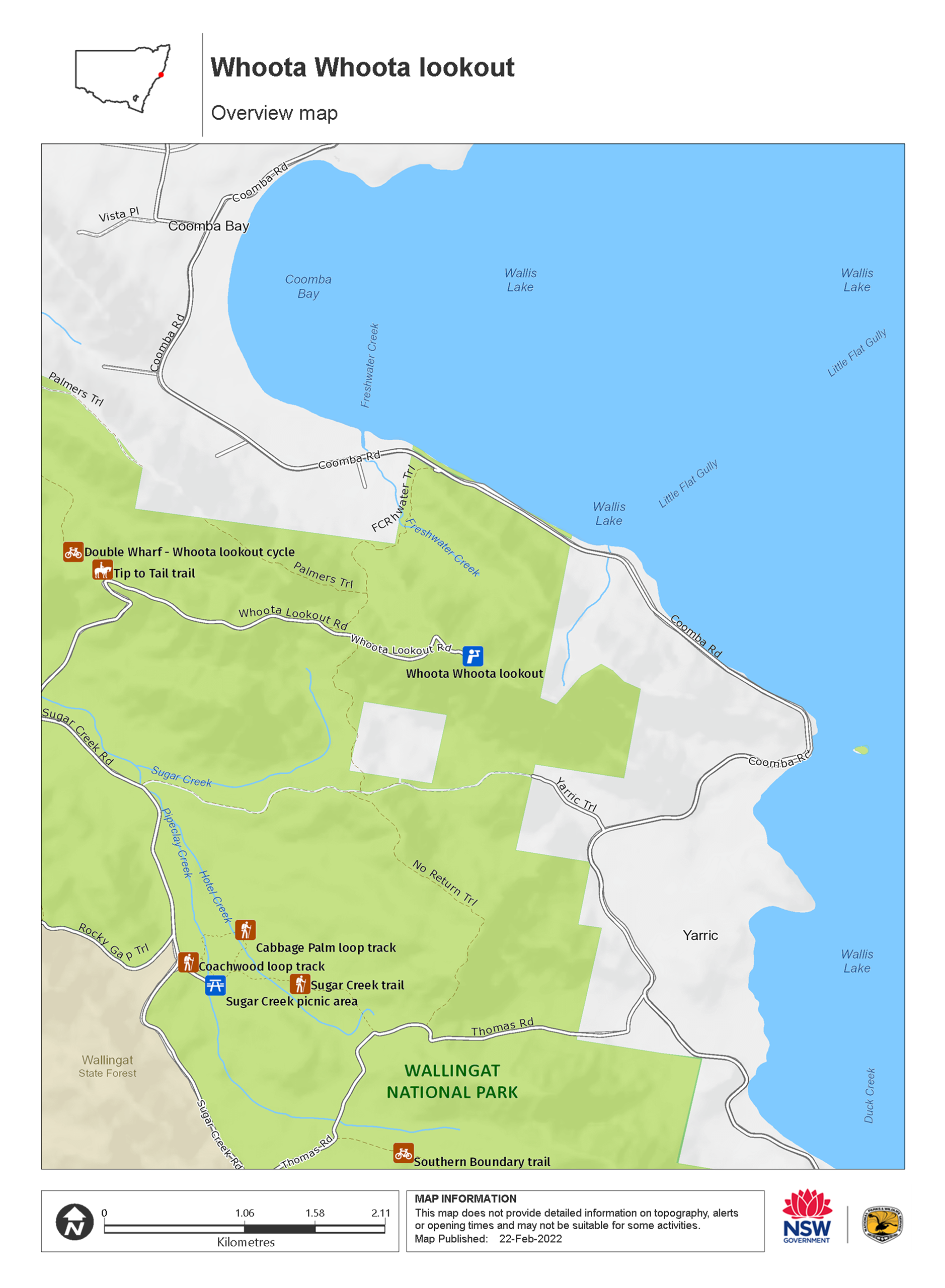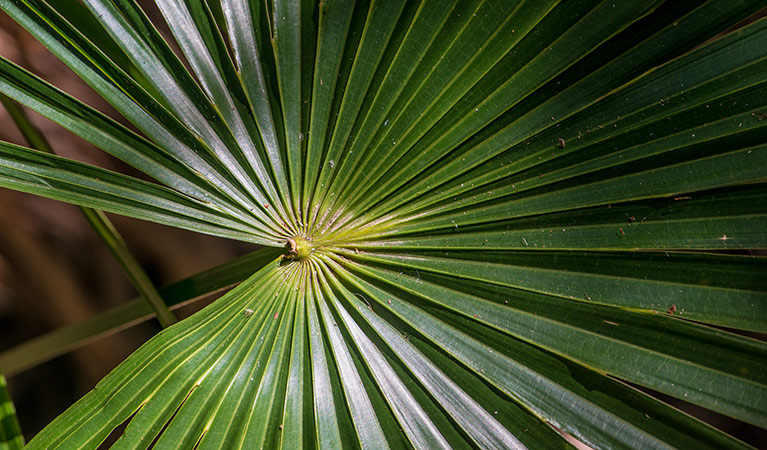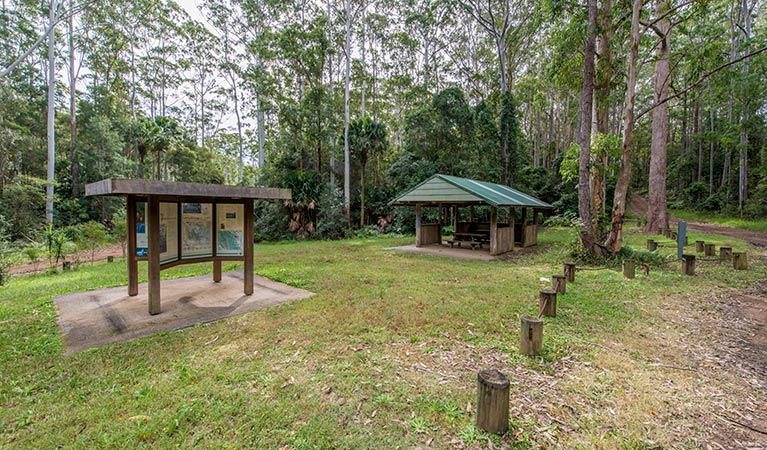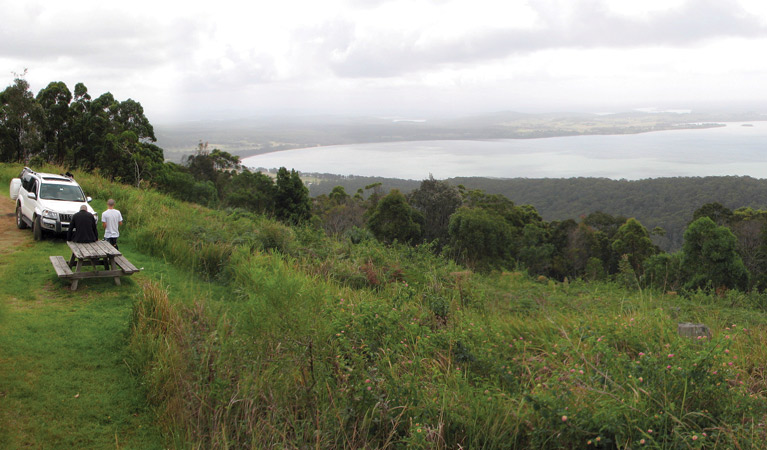Whoota Whoota lookout
Wallingat National Park
Overview
From Whoota Whoota lookout, easily accessible by car, you can see for miles. Take in scenic views of Wallingat’s eucalypt forests, Wallis Lake and 100km of coastline.
- Type
- Lookouts
- Where
- Wallingat National Park in North Coast
- What to
bring - Drinking water
This is not only the best viewpoint in Wallingat National Park, but also one of the greatest in NSW. Drive right up to Whoota Whoota lookout and prepare to be amazed. Peer out one way and you can see the vast stretches of eucalypt forest that make up much of the park. Look in the other direction and you can see the expanse of Wallis Lake as well as the winding, rugged coastline.
If you’re lucky, you might also see the sea eagles that like to soar here. Don’t forget your camera, because this is one view you won’t want to miss. There’s also a picnic table here if you want to dine with the best natural view of the NSW mid-North Coast as your backdrop.
Map

Map legend

Local alerts
For the latest updates on fires, closures and other alerts in this area, see https://uat.nswparks.cloud/things-to-do/lookouts/whoota-whoota-lookout/local-alerts
General enquiries
- National Parks Contact Centre
- 7am to 7pm daily
- 1300 072 757 (13000 PARKS) for the cost of a local call within Australia excluding mobiles
- parks.info@environment.nsw.gov.au
Park info
- in Wallingat National Park in the North Coast region
Wallingat National Park is always open but may have to close at times due to extreme weather or fire danger.
Visitor info
All the practical information you need to know about Whoota Whoota lookout.
Maps and downloads
Learn more
Whoota Whoota lookout is in Wallingat National Park. Here are just some of the reasons why this park is special:
Ancient footprints

The 6,557ha of Wallingat National Park is part of the identity and spirituality, as well as a resource, for people of the Worimi nation. The Worimi People lived a traditional hunter-gatherer lifestyle and used the leaves of the cabbage palm for weaving baskets and its fibrous bark for making fishing line. They used many of the area's natural resources, including the freshwater lakes, stone outcrops, and the ocean. A central campsite was known to exist in the area now known as Coomba Park, although there are few other Aboriginal sites recorded within the park include the Bungwahl area.
Fun times

Whether you're after a relaxing time or something more adventurous, Wallingat is just the spot. Take to the gravel roads either on foot, in a car or on a bike – to explore the forests. You can swim, fish and paddle on Wallingat River. Pitch a tent in the campground and get away from it all for a few days in this naturally beautiful setting. Surrounding some of the picnic areas and campsites, you’ll find magnificent stands of trees. In the southeast corner of Wallingat, there are tall, straight flooded gums, as well as stands of cabbage palms. Find both during a walk from Sugar Creek picnic area. Some rare plants such as the liana woody climber, a climbing species that bears white flowers from August to May, can also be found here.
- Double Wharf trail Experience the scenic waterways and mountainous forests of Wallingat National Park along Double Wharf trail – perfect for walking or mountain bike riding.
- Wallingat Forest drive The 25km loop of Wallingat Forest drive, near Forster, is on unsealed roads that meander through forests, and excellent for cars, 4WDs, bicycles, walking and horse riding.
- Whoota Whoota lookout From Whoota Whoota lookout, easily accessible by car, you can see for miles. Take in scenic views of Wallingat’s eucalypt forests, Wallis Lake and 100km of coastline.
Life among the trees

More than 200 species of birds make Wallingat National Park a home. Walking through forest as well as stands of straight flooded gums, and cabbage palms, you'll hear birds singing. Noisy friarbirds, for instance, have a distinctive 'ya-kob' call, while a 'woop, woop, woop' sound signals the presence of the wonga pigeon. You might see blue wrens flitting through the trees, as well as king parrots and glossy black cockatoos. Wallingat is also a popular spot for the satin bowerbird – the males are black and shiny, the females are a plainer brown. They both, however, have startling lilac eyes.
- Double Wharf trail Experience the scenic waterways and mountainous forests of Wallingat National Park along Double Wharf trail – perfect for walking or mountain bike riding.
- Sugar Creek picnic area Sugar Creek picnic area is a family-friendly relaxation spot with easy walking trails through forested landscape, a leisurely drive from Forster and Pacific Palms.

